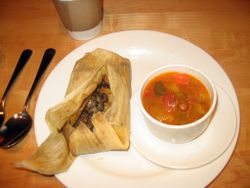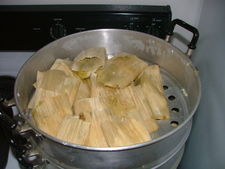
A tamale or tamal (from Nahuatl tamalli) is a traditional Latin American food that begins with a corn meal dough called masa (or a masa mix such as Maseca) mixed with water. This mixture is then filled with meats, cheese (post-colonial) and sliced chiles or any preparation according to taste. The tamale is wrapped in a corn husk for before cooking.
Tamales are an ancient American food, made throughout the continent for over 5000 years. Their essence is the masa maize dough, usually filled with a sweet or savory filling, wrapped in plant leaves or corn husks, and cooked, usually by steaming, until firm. Tamales were developed as a portable ration for use by war parties in the ancient Americas, and were as ubiquitous and varied as the sandwich is today.
Tamales are difficult to make. The procedure in Central and Northern Mexico goes as follows: the masa (about one-inch diameter ball or so) is smeared like butter on the individual corn husk with a spoon. Then the filling (see below) is placed length-wise on the center of the husk; meats (chicken, pork) should be pre-cooked. The sides of the husk are folded and the newly made tamale is steam-cooked for an hour or until the masa has a cake-like consistency. The proportions of filling and masa vary widely according to taste. Once made, however, they can be frozen quite easily (the husks help to keep them from sticking together) and reheated as needed. Because of this, the making of tamales is often a social occasion, with friends and family all pitching into help make hundreds of tamales to be shared out.

Contents |
Tamales in Latin America
Tamales are a favorite quick breakfast dish in Mexico, where street vendors can be seen serving them from huge, steaming, covered pots (tamaleras). In some places like Zacatecas, the tamale is often placed inside a wheat bread roll to form a torta de tamal, which is substantial enough to keep the breakfaster going until Mexico's traditionally late lunch hour.
The most common (and traditional) filling is pork or chicken, in either red or green salsa or mole. Another very traditional variation is to add sugar to the corn mix and fill it with raisins or other dried fruit and make a sweet tamale (tamal de dulce). Instead of corn husks, banana leaves are used in tropical parts of the country such as the states bordering the Gulf of Mexico, Oaxaca, Chiapas, and the Yucatán Peninsula. These tamales are rather square in shape, often very large (15 inches or more) and thick; a local name for these in Southern Tamaulipas is zacahuil. To the south, banana-leaf tamales are also common in the neighboring countries of Central America.
To make a full meal, the tamale is often accompanied by atole, hot chocolate, or champurrado. In El Salvador and Honduras they are wrapped in banana leaves, and there are several varieties, including tamal de gallina, tamal pisque, and tamal de elote. They are generally large, similar in size to the tamales of southeastern Mexico.
In Guatemala, in addition to El Salvador versions, there are Tamales without filling and are served as the bread or starch portion of a meal:
- Tamal de elote (corn tamal sometimes sweet taste and yellow),
- Tamalito de chipilin (Chipilin is a delicious green leaf) or
- Tamal blanco (white tamal made with corn), very simple but unique taste.
During Christmas holidays, tamales of rice flour are a special treat for Guatemalans. The preparation time of this type of tamal is long, due to the amount of time required to cook down and thicken the rice flour base.
Corn-husk wrapped tamales are also popular in southeastern Cuba.
Peruvian tamales tend to be spicy, larger, and are wrapped in banana leaves. Common fillings are chicken or pork, usually accompanied by boiled eggs, olives, peanuts or a piece of chilli pepper. Smaller tamales wrapped in corn husks are called humitas, and are usually sweeter.
Tamales are also found in Colombia, where there are several varieties (including boyacense and santandereano). Ecuador also has a variety of tamales and humitas, they can be filled with fresh cheese, pork, chicken or raisins. Ecuadorian tamales are usually wrapped in corn husk or achira (aka Canna) leaves.
Tamales in the United States
The plural is tamales, and this is the form of the word most often seen in the United States among Hispanics, with the singular frequently given as tamale (seeming incorrect to other Spanish-speakers, who know the correct form is tamal) As tamales have acquired mainstream popularity in the United States, other fillings have become more common, such as beef; another popular filling is corn (partially mashed, like creamed corn). Tamales are popular as Christmas meals in the southwestern states of the USA. A basic modern southwestern tamale contains a spicy meat filling, usually shredded pork or beef, and is often served with a chili con carne sauce.
The tamale is a staple food along the Mississippi Delta. It grew in popularity in the early 1900s when Mexican farmworkers introduced it to black workers in the cotton fields in the deep South.
Tamales in the Caribbean
The tamale is also a staple in Belize, where it is also known (in English) by the Spanish name bollo. Confusion with the nomenclature also leads to the plural form being used as a singular: thus, "a tamales" [rare].
Another variation of the tamale is the pastelle found on the islands of Trinidad and Tobago. It is a Spanish derivative left over from the days when Trinidad was a colony of Spain and thus shares many similarities with its Latin American counterparts. Pastelles are wrapped in banana leaves for cooking and have a rectangular shape, roughly about 6"x3"x1/2" in dimensions varying according to preference. The shell is made of cornmeal and the filling commonly consists of well seasoned ground beef (sometimes substituted with chicken though very rarely) with prunes, raisins, capers, and olives. The result is a rich contrast of sweet, savoury, and salty flavours. It is a staple favourite of the Christmas holiday seasonal foods on the islands, rarely if ever seen during the rest of the year, and served for breakfast, as a supplement to other meals such as lunch and dinner, or on their own as a simple snack along with other seasonal favourites such as sorrel.
External links
Categories: Christmas food
